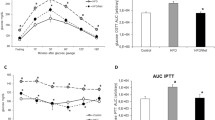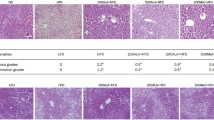Abstract
Increased accumulation of methylglyoxal (MG) has been linked to different insulin resistance states including diabetes and hypertension. In this study, the effects of MG on insulin signaling pathway were investigated. Following 9 weeks of fructose treatment, an insulin resistance state was developed in Sprague-Dawley (SD) rats, demonstrated as increased triglyceride and insulin levels, high blood pressure, and decreased insulin-stimulated glucose uptake by adipose tissue. More importantly, we observed a close correlation between the development of insulin resistance and elevated MG level in serum and adipose tissue. Both insulin resistance state and the elevated MG level were reversed by the MG scavenger, N-acetyl cysteine (NAC). When 3T3-L1 adipocytes were treated directly with MG, the impaired insulin signaling was also observed, indicated by decreased insulin-induced insulin-receptor substrate-1 (IRS-1) tyrosine phosphorylation and the decreased kinase activity of phosphatidylinositol (PI) 3-kinase (PI3K). The ability of NAC to block MG-impairment of PI3K activity and IRS-1 phosphorylation further confirmed the role of MG in the development of insulin resistance. In conclusion, the increase in endogenous MG accumulation impairs insulin-signaling pathway and decreases insulin-stimulated glucose uptake in adipose tissue, which may contribute to the development of insulin resistance.





Similar content being viewed by others
References
Monnier VM, Cerami A (1981) Nonenzymatic browning in vivo: possible process for aging of long-lived proteins. Science 211:491–493
Beisswenger PJ, Drummond KS, Nelson RG et al (2005) Susceptibility to diabetic nephropathy is related to dicarbonyl and oxidative stress. Diabetes 54:3274–3281
Wells-Knecht KJ, Brinkmann E, Wells-Knecht MC et al (1996) New biomarkers of Maillard reaction damage to proteins. Nephrol Dial Transplant 11(Suppl 5):41–47
Wang X, Desai K, Clausen JT et al (2004) Increased methylglyoxal and advanced glycation end products in kidney from spontaneously hypertensive rats. Kidney Int 66:2315–2321
Wang X, Desai K, Chang T et al (2005) Vascular methylglyoxal metabolism and the development of hypertension. J Hypertens 23:1565–1573
Sechi LA, Bartoli E (1997) Mechanisms of insulin resistance leading to hypertension: what we can learn from experimental models. J Investig Med 45:238–251
Yamauchi T, Tobe K, Tamemoto H et al (1996) Insulin signalling and insulin actions in the muscles and livers of insulin-resistant, insulin receptor substrate 1-deficient mice. Mol Cell Biol 16:3074–3084
Cheatham B, Kahn CR (1995) Insulin action and the insulin signaling network. Endocr Rev 16:117–142
Riboulet-Chavey A, Pierron A, Durand I et al (2006) Methylglyoxal impairs the insulin signaling pathways independently of the formation of intracellular reactive oxygen species. Diabetes 55:1289–1299
Wu L, Juurlink BH (2002) Increased methylglyoxal and oxidative stress in hypertensive rat vascular smooth muscle cells. Hypertension 39:809–814
Jia X, Olson DJ, Ross AR et al (2006) Structural and functional changes in human insulin induced by methylglyoxal. Faseb J 9:1555–1557
Brady MJ, Kartha PM, Aysola AA et al (1999) The role of glucose metabolites in the activation and translocation of glycogen synthase by insulin in 3T3-L1 adipocytes. J Biol Chem 274:27497–27504
Wang R, Wang Z, Wu L et al (2001) Reduced vasorelaxant effect of carbon monoxide in diabetes and the underlying mechanisms. Diabetes 50:166–174
Yu PH, Wang M, Fan H, Deng Y et al (2004) Involvement of SSAO-mediated deamination in adipose glucose transport and weight gain in obese diabetic KKAy mice. Am J Physiol Endocrinol Metab 286:E634–E641
McLellan AC, Thornalley PJ, Benn J et al (1994) Glyoxalase system in clinical diabetes mellitus and correlation with diabetic complications. Clin Sci (Lond) 87:21–29
Wu L (2006) Is methylglyoxal a causative factor for hypertension development? Can J Physiol Pharmacol 84:129–139
Kalapos MP (1999) Methylglyoxal in living organisms: chemistry, biochemistry, toxicology and biological implications. Toxicol Lett 110:145–175
Wang H, Meng QH, Chang T et al (2006) Fructose-induced peroxynitrite production is mediated by methylglyoxal in vascular smooth muscle cells. Life Sci 79:2448–2454
Chang T, Wang R, Wu L (2005) Methylglyoxal-induced nitric oxide and peroxynitrite production in vascular smooth muscle cells. Free Radic Biol Med 38:286–293
Fukunaga M, Miyata S, Higo S et al (2005) Methylglyoxal induces apoptosis through oxidative stress-mediated activation of p38 mitogen-activated protein kinase in rat Schwann cells. Ann N Y Acad Sci 1043:151–157
Acknowledgments
This work was supported by operating grants from Canadian Institutes of Health Research (CIHR MOP-68938) and Heart and Stroke Foundation of Saskatchewan to L. Wu. L. Wu is supported by a New Investigator Award from CIHR and X. Jia is supported by a Doctoral Research Award from Heart and Stroke Foundation of Canada.
Author information
Authors and Affiliations
Corresponding author
Rights and permissions
About this article
Cite this article
Jia, X., Wu, L. Accumulation of endogenous methylglyoxal impaired insulin signaling in adipose tissue of fructose-fed rats. Mol Cell Biochem 306, 133–139 (2007). https://doi.org/10.1007/s11010-007-9563-x
Received:
Accepted:
Published:
Issue Date:
DOI: https://doi.org/10.1007/s11010-007-9563-x




